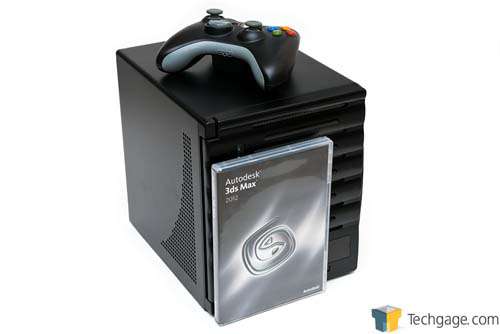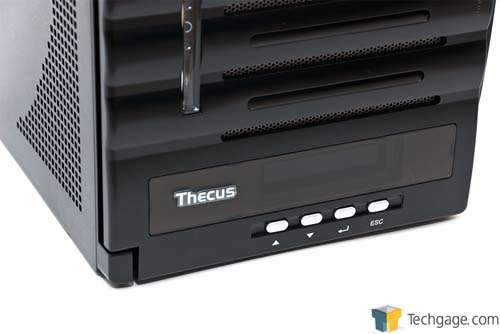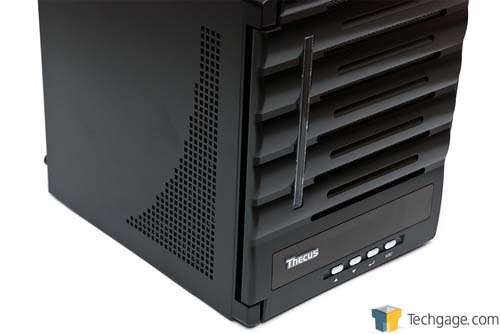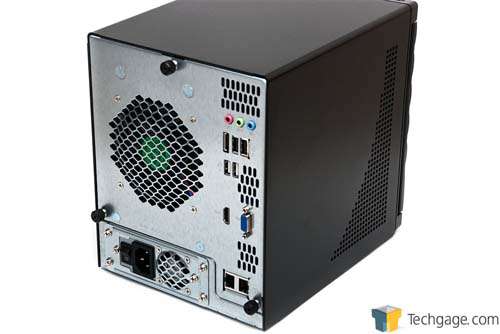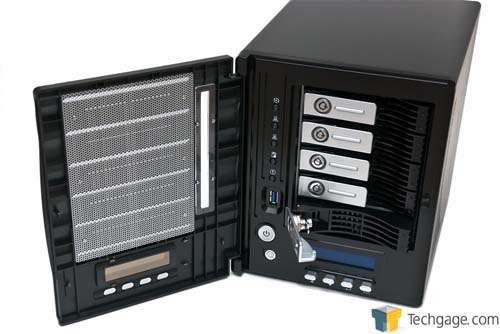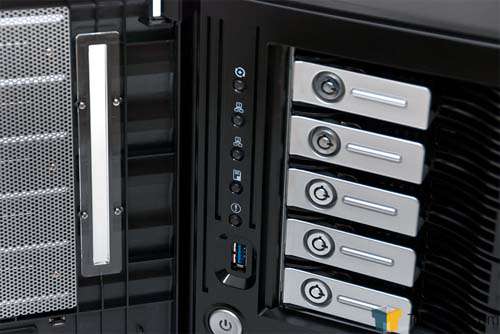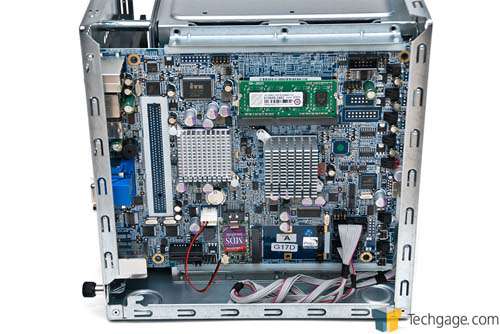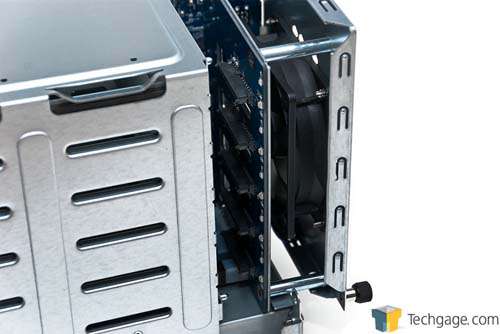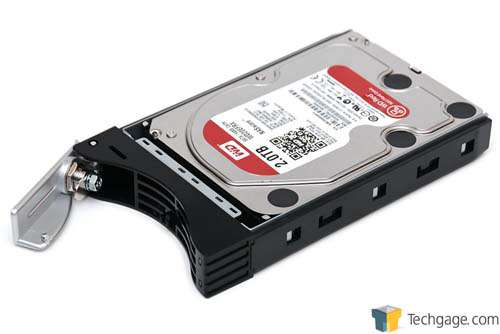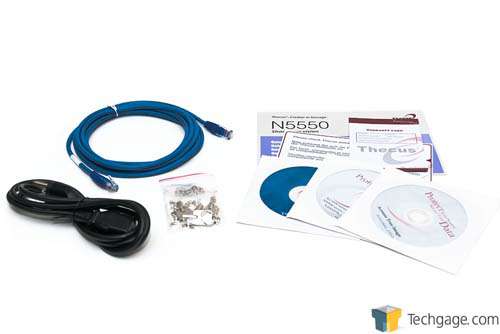- Qualcomm Launches Snapdragon 4 Gen 2 Mobile Platform
- AMD Launches Ryzen PRO 7000 Series Mobile & Desktop Platform
- Intel Launches Sleek Single-Slot Arc Pro A60 Workstation Graphics Card
- NVIDIA Announces Latest Ada Lovelace Additions: GeForce RTX 4060 Ti & RTX 4060
- Maxon Redshift With AMD Radeon GPU Rendering Support Now Available
Thecus N5550 5-bay SMB/SOHO NAS Server Review
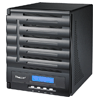
In an environment where uptime and data security is of paramount importance, a 5-bay NAS is an interesting proposition with its allure of huge storage and the ability implement a hot spare. Thecus’ N5550 only adds to the intrigue with its huge feature-set including a USB 3.0 port and 2GB of RAM. Let’s see if the other features can seal the deal.
Page 2 – A Tour of the Thecus N5550: Hardware
The frame of Thecus’ N5550 is pretty modest at 9.05 x 7.48 x 9.45″, but it’s actually fairly heavy at 16lbs. Add 5 normal hard drives to that and it’ll become at least 23lbs. That, along with its heavy-duty frame, instills confidence that a simple nudge isn’t going to hurt the NAS too much, and tripping over it should do little (I think of that latter example for no particular reason…)
To help get a feeling for the size of the N5550, you can compare how an Xbox 360 controller and standard DVD case compare in the shot below. While the the chassis itself is as solid as I could expect it to be, I do wonder about the door.
It’s not likely that you’ll be opening this door often, but a swinging door means there’s a chance someone can run into it when not paying attention – the same risk exists with computer chassis that also have doors. I much prefer the styling of the N4200, but this might be personal taste.
On the topic of the N4200, let’s talk about LCDs. The N4200 has two (OLED), one on the side that displays static colors and another one, monochrome, at the top. Overall, these both look quite nice, and as such, I expected to see something similar on this beefier N5550. But that’s not the case. Instead, the LCD is at the bottom, is very blue, and really doesn’t represent the product as much as I think it should. When a smaller unit gets far cooler displays, it makes you wonder why Thecus decided to stick with the same display the N5500 shipped with.
As a side note, this display does exist for a reason. It allows you to peruse various bits of information if no PC is turned on, such as the status of your RAID rebuilding. Overall, I found this clunky to use, and when I couldn’t find much of an explanation in the manual, I just left it. Generally speaking, this is going to be primarily useful to watch for status updates if the need arises. Once your NAS is setup the way you like, the screen will likely never have to be referred to unless a drive dies. Sadly, it cannot be turned off.
On each side of the N5550 are many holes for air circulation, however at any given time during testing, both sides were barely warm. Most of the heat gets concentrated to the back, which we’ll tackle next.
For the system, Thecus employs an 80mm exhaust fan at the back, while the 200W PSU has its own little fan at the bottom. Given their size, it wouldn’t be unreasonable to expect them to be loud, but even during use I’d have to get quite close to the NAS to be able to hear it. My desktop PC dwarfs the noise entirely, so I’ve never noticed it even running. If you try to keep room noise as quiet as possible, you can expect to hear little more than a mild hum out of this.
As mentioned before, this NAS includes dual LAN ports, audio and video out and four USB ports. Again, it would have been nice if at least one of these USB ports were 3.0 enabled, especially since all motherboards I’ve ever come across have featured two 3.0 ports per chipset at the very least.
At the front and with the door open, we unveil the five drive carriers, status LEDs and the power and reset buttons. These drive carriers have become popular within Thecus’ line of NAS products, and short of being able to secure a drive without drive screws, I couldn’t imagine how they’d get any better.
A closer look at the status LEDs:
Removing the N5550’s chassis is pretty simple. After three thumbscrews at the back are disconnected from the chassis (the screws themselves do not come off of the frame), a little wiggling will allow you to remove the frame from the base. Here, we can get a glimpse at the motherboard, which uses a single DIMM for the 2GB of RAM. If the front LCD display begins to drive you nuts, one of the small cables at the bottom-right can be removed to disconnect it (I am not sure off-hand which one, but you’ll be able to judge from the routing).
I couldn’t quite figure out how to separate one part of the NAS from the rest, so I resort to using the photo below to show the back SATA plane and fan. The airflow scheme has warm air head towards the back and out through the fan. Though the hard drives will be placed directly in front of the fan, the heat still has to travel a little bit before making its way out. This at first concerned me, but even during full-tilt testing, which involved copying terabytes of data, I never exhibited the drives exceeding 45°C.
Behold the drive carrier with an installed WD Red hard drive (it’s my secret if the drive was actually secured for this pic!).
In way of accessories, Thecus includes a Cat5 LAN cable, power cable (identical to those used for our desktop PCs), various bits of documentation, Acronis True Image, some screws to secure the drives to their carriers and a couple of keys to lock the drives into place.
With a look at the hardware taken care of, let’s move on to the software.
Support our efforts! With ad revenue at an all-time low for written websites, we're relying more than ever on reader support to help us continue putting so much effort into this type of content. You can support us by becoming a Patron, or by using our Amazon shopping affiliate links listed through our articles. Thanks for your support!




